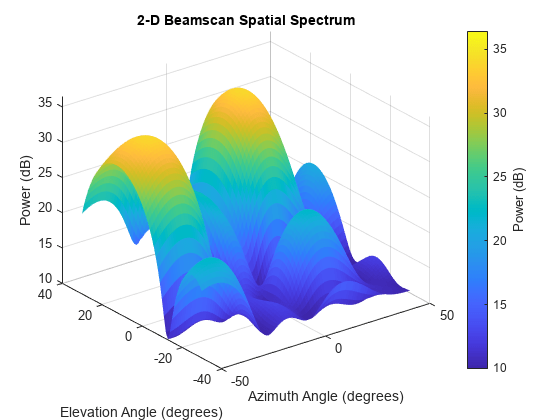phased.BeamscanEstimator2D
2-D beamscan spatial spectrum estimator
Description
The phased.BeamscanEstimator2D
System object™ calculates a beamscan 2-D spatial spectrum estimate for any Phased Array System Toolbox™ array. The object estimates the incoming signal spatial spectrum using a
narrowband conventional beamformer.
To estimate the spatial spectrum:
Create the
phased.BeamscanEstimator2Dobject and set its properties.Call the object with arguments, as if it were a function.
To learn more about how System objects work, see What Are System Objects?
Creation
Description
estimator = phased.BeamscanEstimator2D
estimator = phased.BeamscanEstimator2D(Name,Value)estimator, with each specified property
Name set to the specified Value. You can
specify additional name-value pair arguments in any order as
(Name1,Value1,...,NameN,ValueN).
Properties
Usage
Description
[
returns the directions of arrival, Y,ANG] = estimator(X)ANG, of the signals. To enable
this syntax, set the DOAOutputPort property to
true. ANG is a 2-by-N matrix
of the estimated azimuths and elevations of the signal direction. N is
specified by the NumSignals property. If the object cannot identify a
signal direction, it will return NaN.
Note
The object performs an initialization the first time the object is executed. This
initialization locks nontunable properties
and input specifications, such as dimensions, complexity, and data type of the input data.
If you change a nontunable property or an input specification, the System object issues an error. To change nontunable properties or inputs, you must first
call the release method to unlock the object.
Input Arguments
Output Arguments
Object Functions
To use an object function, specify the
System object as the first input argument. For
example, to release system resources of a System object named obj, use
this syntax:
release(obj)
Examples
Algorithms
References
[1] Van Trees, H. Optimum Array Processing. New York: Wiley-Interscience, 2002.
Extended Capabilities
Version History
Introduced in R2011a
